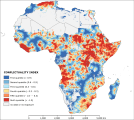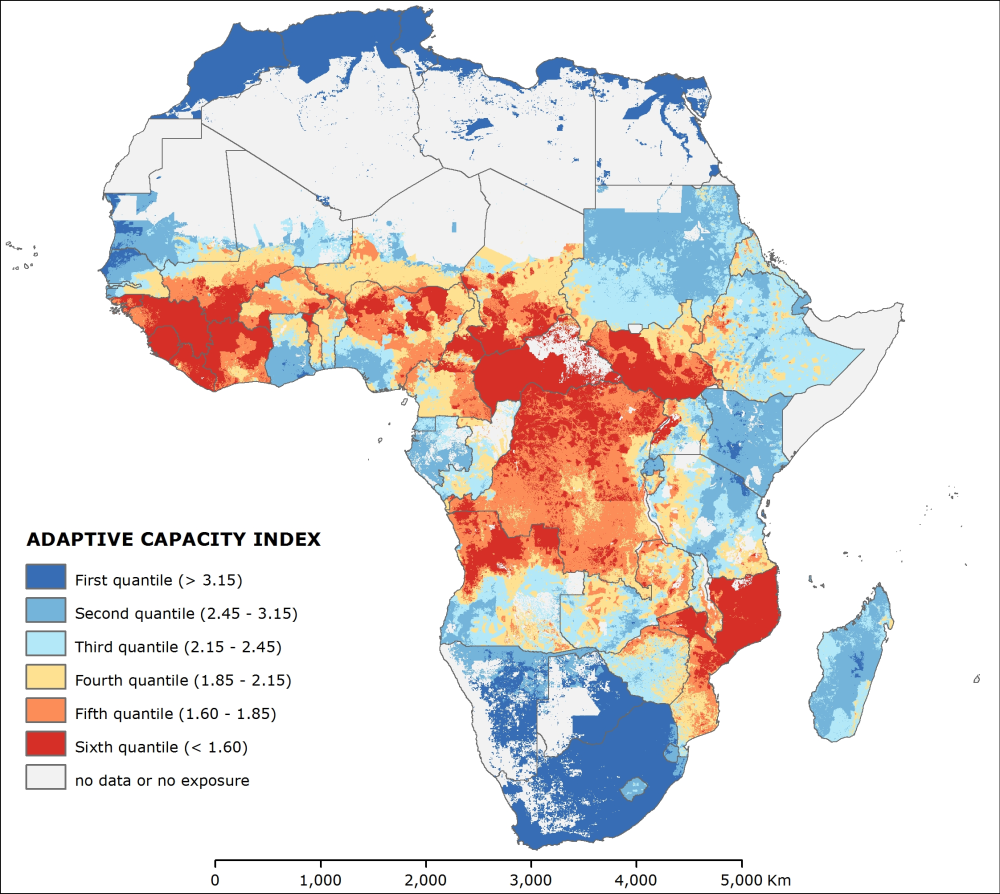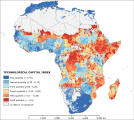adaptive capacity
Type of resources
Available actions
Topics
Keywords
Contact for the resource
Provided by
Years
Formats
Representation types
Update frequencies
status
Resolution
-

The Governance component is formed by the mean of two indicators: the Government effectiveness and the CPI scores. The Government effectiveness captures perceptions of the quality of public services, the quality of the civil service and the degree of its independence from political pressures, the quality of policy formulation and implementation, and the credibility of the government's commitment to such policies. The indicator shows the effectiveness of the governments’ effort for building resilience across all sectors of society. The CPI scores and ranks countries based on how corrupt a country’s public sector is perceived to be. It is a composite index, a combination of surveys and assessments of corruption, collected by a variety of reputable institutions. The indicator captures the level of misuse of political power for private benefit, which is not directly considered in the construction of the government effectiveness even though interrelated.
-

The indicator for the Disaster Risk Reduction (DRR) activity in the country comes from the score of Hyogo Framework for Action self-assessment progress reports of the countries. HFA progress reports assess strategic priorities in the implementation of disaster risk reduction actions and establish baselines on levels of progress achieved in implementing the HFA's five priorities for action.
-

This dataset on credit to agricultural sector provides national data for over 120 countries on the amount of loans provided by the private/commercial banking sector to producers in agriculture, forestry and fisheries, including household producers, cooperatives, and agro-businesses. For some countries, the three subsectors of agriculture, forestry, and fishing are completely specified. In other cases, complete disaggregations are not available. The dataset also provides statistics on the total credit to all industries, indicators on the share of credit to agricultural producers, and an agriculture orientation index (the agriculture share of credit, over the agriculture share of GDP).
-

The dataset presents the countries where the community has the economic means (>20 000 USD/year) to adapt to climate change and associated hazards. This indicator provides per capita values for gross domestic product (GDP) expressed in current international dollars converted by purchasing power parity (PPP) conversion factor. GDP is the sum of gross value added by all resident producers in the country plus any product taxes and minus any subsidies not included in the value of the products. conversion factor is a spatial price deflator and currency converter that controls for price level differences between countries. Total population is a mid-year population based on the de facto definition of population, which counts all residents regardless of legal status or citizenship.
-

The “conflictuality index” describes the impact that conflicts have in a certain area in 2010. Area subjected to violence and conflict may have problem to receive assistance to develop adaptation measures and may lack the wiliness of the authority to implement such adaptation. The index results from the second cluster of the Principal Component Analysis preformed among 18 potential variables. The analysis identifies two dominant variables, namely “distance from conflict events” and “conflict events density”, assigning equal weights (0.5) to the two variables. Before to perform the analysis the variables were log transformed to shorten the extreme variation and then were score-standardized (converted to distribution with average of 0 and standard deviation of 1; inverse method was applied for “conflicts events density”) in order to be comparable. A shapefile of conflict events was gathered from the Uppsala Conflict Data Programme (UCDP). Considering that the effect of conflict aftermath may during years, we collect all the events position and number of victims from 1989 to 2010. The “distance from conflicts” was obtained via Euclidean distance calculation of the conflict events. The “conflict events density” is the result of a kernel density analysis on number of victims with a search radius of 200 Kilometer. This dataset has been produced in the framework of the “Climate change predictions in Sub-Saharan Africa: impacts and adaptations (ClimAfrica)” project, Work Package 4 (WP4). More information on ClimAfrica project is provided in the Supplemental Information section of this metadata.
-

The “adaptive capacity index” symbolizes the adaptive potential to implement adaptation measures that help avert potential impacts in 2010. Adaptive capacity is a significant factor in characterizing vulnerability. The IPCC (2001) describes adaptive capacity as the potential or ability of a system, region, or community to adjust to the effects or impacts of climate change (including climate variability and extremes). Adaptive capacity is considered to be “a function of wealth, technology, education, information, infrastructure, skills, access to resources and stability and management capabilities”. The means of the adaptive capacity are the assets and entitlements that communities and individuals can mobilize in the face of environmental change. The more assets people have, the less vulnerable they are and vice versa. Here adaptive capacity is described as being dependent upon four assets: human capital, technological capital, financial capital and institutional capital. Therefore, the “adaptive capacity index” derived from the addition of four underlying indexes: the “human capital index”, the “technological capital index”, the “financial capital index” and the “institutional capital index”. Principal Component Analysis determines the weights of the four underlying indexes. The analysis run among the variables that compose such indexes and results in four weights: 0.58 for the “human capital index”, 0.16 for the “technological capital index”, 0.20 for the “financial capital index” and finally 0.06 for the “institutional capital index”. This dataset has been produced in the framework of the “Climate change predictions in Sub-Saharan Africa: impacts and adaptations (ClimAfrica)” project, Work Package 4 (WP4). More information on ClimAfrica project is provided in the Supplemental Information section of this metadata.
-

The “technological capital index” symbolizes the physical means that determine the potential adaptive capacity degree of a particular unit of analysis in 2010. It is linked with the diffusion of basic life technology and infrastructure (e.g. transportation network). It is the combination of two underlying indexes: the “household technology index” and the “infrastructure index”. These original indexes correspond to the two principal components recognized by Principal Component Analysis among 10 potential variables. The analysis assigned relative weights to the “household technology index” and the “infrastructure index”, that are 0.62 and 0.38, respectively. This dataset has been produced in the framework of the “Climate change predictions in Sub-Saharan Africa: impacts and adaptations (ClimAfrica)” project, Work Package 4 (WP4). More information on ClimAfrica project is provided in the Supplemental Information section of this metadata.
-

The “institutional capital index” relates to the management means that determine the potential adaptive capacity degree of a particular governance institution in 2010. It is linked with the governance capacity and behavior, the tendency to conflict and the ability to manage environmental issue of a certain governmental institution. It is the combination of three underlying indexes: the “governance index”, “conflictuality index” and the “environmental management index”. These original indexes correspond to the three principal components identified by Principal Component Analysis among 18 potential variables. The analysis assigned the relative weights of 0.6 , 0.3 and 0.1 for the “governance index”, “conflictuality index” and the “environmental management index”, respectively. This dataset has been produced in the framework of the “Climate change predictions in Sub-Saharan Africa: impacts and adaptations (ClimAfrica)” project, Work Package 4 (WP4). More information on ClimAfrica project is provided in the Supplemental Information section of this metadata.
-

The “vulnerability index” represents the level of vulnerability of a certain region to climate change impacts, given the situation of 2010. The index results from the multiplication of the “exposure index” by the “sensitive index”, and divided by the “adaptive capacity index”. The relative weights were defined through Principal Component Analysis (PCA) among the natural logarithm of the variables which compose the underlying indexes, and they were used like exponential coefficient (0.11 for exposure, 0.33 for sensitivity and 0.56 for adaptive capacity). Alternatively an additive model can be adopted. In this case the PCA run among the underlying variables. However, the result was not significantly different. This dataset has been produced in the framework of the “Climate change predictions in Sub-Saharan Africa: impacts and adaptations (ClimAfrica)” project, Work Package 4 (WP4). More information on ClimAfrica project is provided in the Supplemental Information section of this metadata.
-

This dataset assesses the adaptive capacity of a system or a community to cope with or adjust to the adverse effects of climate change and associated hazards, considering the available information on the following indicators: - Access to basic needs as electricity; - Distance to major roads and markets; - Access to weather information, including climate variability and extremes; - Access to information through ICTs, phones, or other means; - Disaster risk reduction capacity through adaptation plans and/or robust disaster risk reduction measures; - Government effectiveness to supports local communities in the adaptation and/or mitigation climate change effects; - Economic means to adapt to climate change and associated hazards; - Share of total government expenditure invested in agriculture, forestry, and fishing.
 FAO Map Catalog
FAO Map Catalog